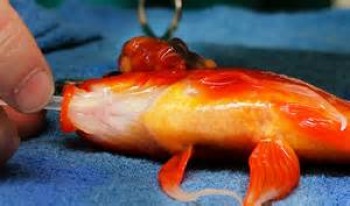Fish
Hallucinogenic Fish

Sarpa salpa (above) is a type of sea bream found in the Mediterranean as well as in temperate areas of the Indian and Pacific Oceans. It has one unusual quality. Eating it can cause hallucinations. For this reason, it's sometimes called the "dreamfish."
People have known about this for a long time. Apparently Sarpa salpa was occasionally eaten for recreational purposes during the Roman Empire.
A 2006 article in the journal Clinical Toxicology describes some medical case reports involving dreamfish consumption. For instance, in 1994 a 40-year-old man on vacation in the French Riviera ate some, and the next day the hallucinations began:
Similarly, in 2002 a 90-year-old retiree ate some sea bream, again in the French Riviera, and experienced hallucinations involving "human screams and bird squealing."
A case described on Wikipedia seems to have been far more pleasurable. In 1960, National Geographic photographer Joe Roberts purposefully ate some broiled dreamfish: "he experienced intense hallucinations with a science-fiction theme that included futuristic vehicles, images of space exploration, and monuments marking humanity's first trips into space."
The authors of the Clinical Toxicology article note that cases of hallucinogenic fish poisoning (ichthyoallyeinotoxism) are often confused with ciguatera poisoning — the latter caused by fish flesh contaminated by "various toxins produced by the benthic dinoflagellate Gambierdiscus toxicus."
Ciguatera can also cause hallucinations. However, it may also kill you, whereas you should recover from the dreamfish hallucinations within 36 hours.
(Thanks to hotsauce269 for letting us know about the dreamfish.)
Posted By: Alex - Fri Dec 02, 2016 -
Comments (4)
Category: Drugs, Fish
Da-Dum… Da-Dum… Da-Dum

Researchers at UC San Diego (my grad school alma mater) have published research documenting that the "ominous background music that often accompanies shark footage" can cause people to view sharks in a negative light, whereas the same footage set to "uplifting background music" doesn't have this effect.
They note that their study is the first "to demonstrate empirically that the connotative attributes of background music accompanying shark footage affect viewers’ attitudes toward sharks."
Posted By: Alex - Wed Aug 17, 2016 -
Comments (4)
Category: Animals, Fish, Documentaries
Flying Fish a Hazard

[Click to enlarge]
Original article here.
Posted By: Paul - Sun Feb 07, 2016 -
Comments (4)
Category: Fish, Air Travel and Airlines, 1980s, North America
Third Eye
The fisherman said he was going to eat the fish. Without knowing why it developed a third eye I wouldn't touch it much less eat it!
Posted By: Alex - Tue Nov 10, 2015 -
Comments (5)
Category: Nature, Fish, Eyes and Vision
Reverse Fishing
Watch the Killer Whale lure a bird in with a well placed fish and score a non fish dinner for himself.
Posted By: Alex - Sun Aug 30, 2015 -
Comments (3)
Category: Intelligence, Fish, Eating
Dolphina at Bimbo’s 365 Club

Bimbo's 365 Club is still an active music venue in San Francisco. But, according to news on their own website, they seem to have abandoned a long proud tradition: Dolphina, the miniature live nude woman who swims in a fishbowl with goldfish.
How was this illusion achieved? When Dolphina was profiled in the NY TIMES in 2011, we learned:
IT’S AN ILLUSION A catacomb of tunnels in the bowels of the club leads to a small room containing a rotating platform on which the live “mermaid” reclines, naked. A periscope with angled mirrors projects her image up into the fishbowl where it appears that a tiny mermaid, about six inches long, is floating in an underwater grotto.
One at least hopes that the statue to an ideal Dolphina, erected in 1952 inside the club, still has a place of honor.


Posted By: Paul - Mon Mar 02, 2015 -
Comments (2)
Category: Entertainment, Public Indecency, Fish, 1950s
Little Irvy the Frozen Whale

"Little Irvy" was a 20-ton whale harpooned on July 1, 1967, destined to be sold as dog food. But instead his body was bought by showman Jerry "Tyrone" Malone, who froze it with liquid nitrogen and then spent the next 25 years hauling it around the United States in a refrigerated truck, displaying it as a sideshow attraction. Malone advertised Little Irvy with a sign that read, "This exhibit is dedicated to the preservation of whales."
Read more about Little Irvy in Dewey Webb's article at SideshowWorld.com. Webb notes that, because of freezer burn, Little Irvy looked "less like a whale than... a gigantic semideflated tire that's lost its tread."
Malone also wrote a children's book about his adventures on the road with Little Irvy. You can buy a used copy of this book at Amazon for $46.11. But if you want a new copy it'll apparently cost you $6,946.01, which, since the book is 42 pages long, is $165.38 a page.
Posted By: Alex - Mon Jan 12, 2015 -
Comments (6)
Category: Fish, 1960s
Fish Eyes
Veterinary staff at Vancouver Aquarium have provided posthetic eyes for a fish. This was done so other fish would not pick it to death because it did not have eyes. So, it seems that humans are not the only species that picks on those who are different.
Posted By: Alex - Thu Jan 08, 2015 -
Comments (8)
Category: Animals, Fish, Eyes and Vision
Expensive Fish Meal

[Click to enlarge]
Original article here.


Posted By: Paul - Sun Nov 09, 2014 -
Comments (2)
Category: Food, Stupid Criminals, Fish, 1980s
A Pet Well Loved

Would you pay 'a few hundred dollars' for high risk brain surgery on a gold fish? Well, this pet's owner felt it was worth the expense. George came though just fine. If you'd like to see more pictures they are available on yahoo images.
Posted By: Alex - Thu Sep 18, 2014 -
Comments (11)
Category: Pets, Fish

| Who We Are |
|---|
| Alex Boese Alex is the creator and curator of the Museum of Hoaxes. He's also the author of various weird, non-fiction, science-themed books such as Elephants on Acid and Psychedelic Apes. Paul Di Filippo Paul has been paid to put weird ideas into fictional form for over thirty years, in his career as a noted science fiction writer. He has recently begun blogging on many curious topics with three fellow writers at The Inferior 4+1. Contact Us |





